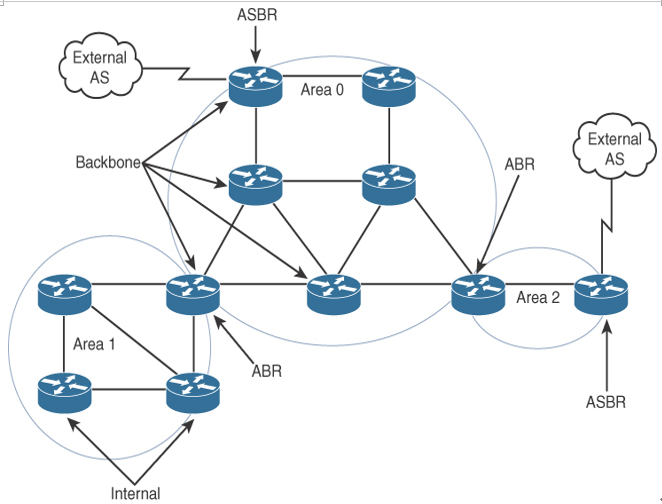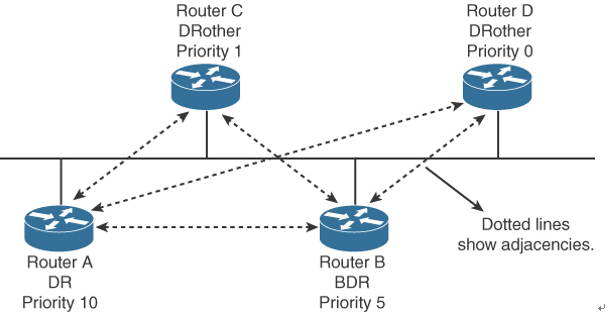OSPF Router Types – OSPF, BGP, and Route Manipulation
OSPF classifies participating routers based on their place and function in the area architecture. Figure 4-4 shows OSPF router types.

Figure 4-4 OSPF Router Types
Table 4-3 explains the router types shown in Figure 4-4.
Table 4-3 OSPF Router Types
| Type | Description |
| Internal router | Any router whose interfaces all belong to the same OSPF area. Such a router keeps only one link-state database. |
| Area border router (ABR) | A router that is connected to more than one area. Such a router maintains a link-state database for each area it belongs to. These routers generate summary LSAs. |
| Autonomous system boundary router (ASBR) | A router that injects external LSAs into the OSPF database (redistribution). These external routes are learned either through other routing protocols or static routes. |
| Backbone router | A router with at least one interface attached to Area 0. |
Tip
An OSPF router can be an ABR, an ASBR, and a backbone router at the same time. A router is an ABR if it has an interface on Area 0 and another interface in another area. A router is a backbone router if it has one or more interfaces in Area 0. A router is an ASBR if it redistributes external routes into the OSPF network.
OSPF DRs
On multiaccess networks (such as Ethernet), some routers get selected as DRs. The purpose of a DR is to collect LSAs for the multiaccess network and to forward the LSAs to all non-DR routers; this arrangement reduces the amount of LSA traffic generated. A router can be the DR for one multiaccess network and not the DR in another attached multiaccess network.
The DR also floods the network LSAs to the rest of the area. OSPF also selects a BDR; it takes over the function of the DR if the DR fails. Both the DR and the BDR become adjacent to all routers in the multiaccess network. All routers that are not a DR or a BDR are sometimes called DROTHERs. These routers are only adjacent to the DR and BDR. The DR generates a Type 2 (network) LSA, which advertises all other routers on the multiaccess segment. This allows the DROTHERs to get the Type 1 LSAs. OSPF routers multicast LSAs only to adjacent routers. DROTHERs multicast packets to the DR and BDR using the multicast address 224.0.0.6 (ALLDRouters). The DR floods updates using ALLSPFRouters (224.0.0.5).
DR and BDR selection is based on an OSPF DR interface priority. The default value is 1, and the highest priority determines the DR. In a tie, OSPF uses the numerically highest router ID. The router ID is the IP address of the configured loopback interface. The router ID is the highest configured loopback address, or if the loopback is not configured, it’s the highest physical address. Routers with a priority of 0 are not considered for DR/BDR selection. The dotted lines in Figure 4-5 show the adjacencies in the network.

Figure 4-5 DRs
In Figure 4-5, Router A is configured with a priority of 10, and Router B is configured with a priority of 5. Assuming that these routers are turned on simultaneously, Router A becomes the DR for the Ethernet network. Router C has a lower priority and becomes adjacent to Router A and Router B but not to Router D. Router D has a priority of 0 and therefore is not a candidate to become a DR or BDR.
If you introduce to a network a new router that has a higher priority than that of the current DR and BDR, it does not become the selected DR unless both the DR and the BDR fail. If the DR fails, the current BDR becomes the DR.
